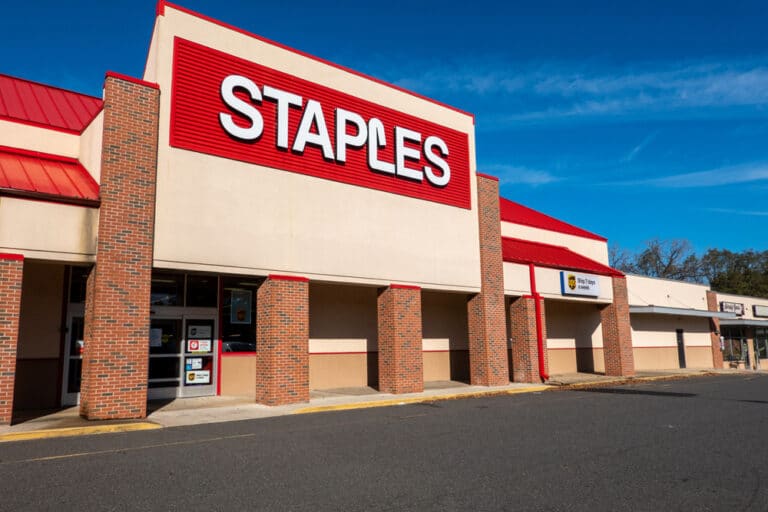We write about the importance of having a backup and disaster recovery policy on a regular basis. But what does that mean in practice? We spoke to Aleh Sadaunichy, Infrastructure Solutions Architect at Staples Solutions, who fairly recently implemented a new approach using Veeam.
Staples Solutions provides workplace services and products to companies of all sizes. It has locations and departments all over the world, serving businesses through retail and online channels. IT, especially the infrastructure, plays a crucial role in this. Without good infrastructure, it becomes difficult for an organization like Staples Solutions to serve customers. The right backup and disaster recovery approach protects that infrastructure, ensuring maximum availability.
Situation had become untenable
Sadaunichy tells us that Staples Solutions began a project in 2018 to revamp its data protection strategy. The policies in place before had actually become too complex. Staples Solutions’ locations had all deployed backup and disaster recovery solutions on their own. That is, a fragmented landscape with dozens of approaches being used by the locations. Different vendors provided Staples Solutions with data management capabilities
Backup and disaster recovery became too complex
According to Sadaunichy, some good solutions were being used, but the situation was almost unworkable. Ensuring availability was complex and costly due to licences and hardware. Every month, the IT department spent a lot of time on backup management and updating licences. Centralisation and simplification were therefore desirable. The modernization process was thus initiated.
Staples Solutions formulated the requirements and went in search of a vendor who could meet them. Sadaunichy wanted a data management platform with a strong software focus and a hardware-neutral approach to run in any location. There were also requirements for on-premises backup, as well as for Azure Blob Storage. In addition, the company had requirements for its ERP software and Microsoft Office 365. Based on these requirements, Staples Solutions found Veeam, the vendor it already used at some locations.
How is the match?
While Sadaunichy sees that there are many good solutions on the market, he says the choice for Veeam worked out well. Initially, the Veeam Availability Suite was implemented. This gives Staples Solutions backup, replication and snapshot capabilities. It also provides a centralized approach to monitoring data in both on-premises and cloud environments, ensuring that everything is secure and in line with guidelines.
Looking more specifically at Staples Solutions’ situation, it’s easy to see why support from data management solutions is needed. For example, Veeam provides backup and replication of 600 TB of data from 1500 virtual machines from HPE Nimble Storage Snapshots (on-premises) and to Azure Blob Storage. This is one of how Sadaunichy’s neutral desire is confirmed: it works with commonly used infrastructure solutions. In this case, from HPE. However, there are also extensive integrations with Dell, NetApp, Pure Storage, and Huawei. Those integrations may not all be relevant to Staples Solutions, but other companies can take advantage of them. With Veeam, it often doesn’t matter which infrastructure solutions are being used.
Staples Solutions has gone from a fragmented data protection strategy to a unified approach
Backup for Office 365
Staples Solutions also relies on the Veeam product Backup for Office 365, with which additional backup steps are taken. This is necessary because Microsoft itself does not take sufficient protection steps. The responsibility for this lies with the customer. Sadaunichy says that Veeam was the choice in this area when the organisation switched to Office 365. The workplace specialist wanted to make on-premises backups of 50 TB of Office 365 data, including thousands of mailboxes, for quick and easy recovery. Sadaunichy also sees the capabilities with Microsoft products as an advantage, as those solutions generated more data at a rapid pace during the Covid-19 pandemic. With Backup for Office 365 functionality Explorers, the company can perform recovery for Microsoft Teams when employees accidentally delete items. According to Sadaunichy, it all happens very quickly, in line with availability requirements.
The Infrastructure Solutions Architect at Staples Solutions says he is generally pleased with the progress made. The company has gone from a fragmented data protection strategy to a unified approach. This way, the goals at the start of the modernization project are reached: less time spent on administration. While Staples Solutions’ IT staff has had to switch to new solutions because they might have used other products than Veeam, Sadaunichy says the platform’s user-friendliness means it’s not a big problem.
When we ask Sadaunichy what could be improved, he says that he would like to see the product become cheaper. He also notes, however, that he already finds Veeam to be well priced compared to competing solutions and that there are many cost savings compared to the old strategy anyway. Veeam could also take steps to modernise its customer portal, as it still looks somewhat dated.
Looking forward to Kasten
At the end of the day, opting for a new uniform approach has worked well for Staples Solutions. Sadaunichy says the company will continue to do a lot of backups. So the Staples Solutions IT team is looking forward to additional Veeam functionality. This includes more direct restore capabilities for Oracle and SQL, as well as additional functionality for Kubernetes and containers. The latter technologies are playing an increasingly important role in Staples Solutions’ strategy, so Sadaunichy is looking forward to the capabilities Kasten, the technology acquired by Veeam will provide. In turn, Kasten plays a prominent role in Veeam’s Kubernetes and containers strategy.
So there’s still plenty on the horizon for Staples Solutions in terms of further optimizing its data protection policies. In any case, the company is a good example of how modernizing and structuring data protection policies can work in practice.
Also read: Veeam commits to Kubernetes Backup with Kasten acquisition
